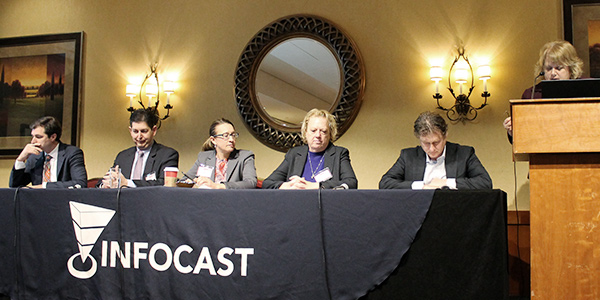By Michael Brooks
WASHINGTON — Storage resources seeking to provide capacity would face much tougher requirements in some regions than others under proposed tariff revisions filed by RTOs and ISOs last week in compliance with FERC Order 841.
Storage offering capacity would have to continuously supply energy for two hours in ISO-NE, but four hours in NYISO and 10 hours in PJM.
Together, the filings by CAISO (ER19-468), ISO-NE (ER19-470), MISO (ER19-465), NYISO (ER19-467), PJM (ER19-469) and SPP (ER19-460) total more than 2,500 pages. FERC, grid operators and stakeholders now have a year to review, revise and implement the plans under a Dec. 3, 2019, deadline set by the commission when it issued Order 841 in February. (See FERC Rules to Boost Storage Role in Markets.)
The complexity of the revisions led some grid operators to ask FERC to rule on their proposals quickly to give them enough time to implement all the changes by the deadline.
“The implementation of the revisions proposed herein is estimated to cost SPP alone in excess of $800,000, and the magnitude of the effort requires major software and process changes to core SPP systems,” said the RTO, which requested FERC rule by March 1.
NYISO requested that FERC rule by Feb. 1, and it further asked that its implementation deadline be extended to May 1, 2020, because it is in the middle of “a significant upgrade” to its market software.
While MISO did not request an extension, it too is undergoing an overhaul of its market platform, noted Tanya Paslawski, executive director of the Organization of MISO States.
Speaking at Infocast’s Federal Energy Policy Summit on Thursday, Paslawski said “there are limits to what [the RTO] can do” to implement the order given its outdated system. For example, MISO established a 100-kW minimum size requirement for resources — the maximum allowed by the order — “because MISO’s existing market systems do not support offer or bid quantities less than this amount.”
Comments on the filings are due by Dec. 24. Several industry groups — including Advanced Energy Economy, the American Wind Energy Association and the Solar Energy Industries Association — filed a joint request to extend the comment period for another 45 days.
“The standard 21-day comment period will not be adequate for interested parties to review and comment on all of the RTO/ISO compliance filings,” the groups said. “The filings are voluminous and contain proposed revisions to several tariff provisions and market rules.” They also noted that the comment deadline is “in the middle of the holiday season, when many organizations are short-staffed.”
“I think it’s probably likely that the comment deadline gets extended,” Scott Baker, senior business solutions analyst for PJM, said at the summit.
Requirements Vary
Each grid operator submitted a participation model for storage resources to provide any services of which they are capable, but requirements vary.
“RTOs have largely allowed storage to provide the same services, under the same conditions, as a provided by other types of resources. Sometimes this creates barriers to storage participation,” the New York School of Law’s Institute for Policy Integrity said in an analysis of the filings.
PJM’s “onerous” 10-hour requirement is only possible for most resources “through significant derating of capacity, and even then may not facilitate cost-effective participation in the capacity market,” the institute said.
“PJM also has proposed an accounting framework that effectively requires all charging by energy storage resources participating in PJM’s participation model that are not owned by load-serving entities to discharge (sell their energy) back to PJM,” it continued. “These resources cannot sell to others or use the stored power themselves.”
As for energy markets, resources would have flexibility under the proposals, with some grid operators allowing suppliers to participate in different “modes.” How many modes — and what they’re called — depends on the region.
PJM, for example, proposed to allow three modes: continuous, charge or discharge. In continuous mode, resources can both charge and discharge, with no limitations on start-ups or ramp rate.
NYISO would offer four modes: ISO-committed fixed, ISO-committed flexible, self-committed fixed and self-committed flexible. In the ISO-committed modes, suppliers would leave it up to NYISO to determine the most optimal dispatch times for their resources. In the fixed mode, the ISO would schedule them in the day-ahead market and dispatch them no more frequently than every 15 minutes in the real-time market. In the flexible mode, NYISO would dispatch resources in the real-time market based on LMPs. In the self-committed modes, suppliers would make these decisions themselves.
MISO would allow for eight “commitment statuses”: discharge, emergency discharge, charge, emergency charge, continuous, available, not participating and outage (offline). (See MISO Offers Storage Proposal, Promises to Exceed Order 841.)
Under the proposals, resources will able to participate in any market they choose, without having to participate in others. For example, Baker noted that PJM currently requires resources wishing to provide synchronized reserves also participate in the RTO’s energy market. “In other words, if you were just a battery that didn’t want to participate in the energy market, but you were sitting there and have the capability to respond within 10 minutes to a synchronized reserve signal, we didn’t have the ability for a resource like that to do that,” he said.
In part because of California legislation requiring investor-owned utilities to procure storage, CAISO filed the fewest revisions among the grid operators. One of the more significant changes was that it reduced its minimum size requirement from 500 kW to 100 kW, Andrew Ulmer, ISO director of federal regulatory affairs, noted Thursday.
SPP noted that it gave storage resources in its footprint — all of which are currently pumped hydro and not able to vary their dispatch mode — the ability to stick with its current model for participation or register as a market storage resource (MSR).






